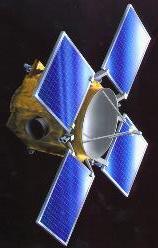
Progress report: 07Jul99
Task:
Processes:
We then went back to the actual sequence. We made new .REQ files for each of the time periods, using the 1 by 3 mosaic. We made an overall plate model with the 1 by 3 mosaic .REQ files. Emily found seven nearest-equatorial 5/5.5 hour time periods, because equatorial time periods seem to give the best results in off nadir pointing. We went through each of those time periods frame by frame and pointed the camera off nadir, however we saw fit, to give better low emission angles, then we made full plate models of the asteroid with only that one 5/5.5 hour time period modified, and compared them to a model of the whole asteroid using all nadir pointing. For descriptions of the differences, go to hermes.earth.nwu.edu:/work2/jedmonds/orbit/100k/lon_scans/1by3_for_sequence/README and hermes.earth.nwu.edu:/work2/jedmonds/orbit/100k/lon_scans/1by3_for_sequence/README2.
We combined the most effective of these time periods in different combinations in which the camera pointed off nadir for three time periods, and made full plate models. We also did that for only two 5/5.5 hour periods pointed off nadir.
Finally, we made plate models using the frm2iep -max (which means that instead of using the frame with the lowest emission angle if that area was covered twice, the plate model uses the highest emission angle). By doing this we could see what kind of stereo coverage we got on our the "off nadir for two" and the "off nadir for three" cases.
Findings:
Going back to the sequence, we found that off nadir pointing for some of the periods is much more effective than for others. When we combined these, we got very good results. Using only two 5/5.5 hour time periods with off nadir pointing, we get much more low emission angle coverage than with all nadir pointing. Using three periods with off nadir pointing, we get even more low emission angle coverage. (The best case of the former altered the camera angle of the time periods 106:19:00 to 107:00:00 and 101:18:00 to 102:00:00 and is called 06:19_01:18.plate. It can be found in hermes:/work2/jedmonds/orbit/100k/lon_scans/1by3_for_sequence. The best case of the latter altered the camera angle of the time periods 106:19:00 to 107:00:00, 101:18:00 to 102:00:00, and 106:13:30 to 106:19:00 and is called 01:18_06:13_06:19.plate. It can also be found in hermes.earth.nwu.edu:/work2/jedmonds/orbit/100k/lon_scans/1by3_for_sequence.)
The max plate models showed that we got really good stereo coverage for both the "off nadir for two" and the "off nadir for three" cases. That was one of the original criteria. (The max plate models are called 06:19_01:18max.plate and 01:18_06:13_06:19max.plate, and can also be found in hermes.earth.nwu.edu:/work2/jedmonds/orbit/100k/lon_scans/1by3_for_sequence).
(Jessica Edmonds and Emily Peters, 7-7-99)